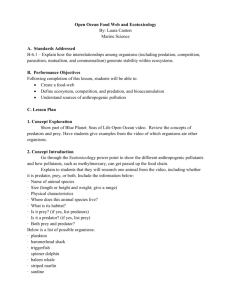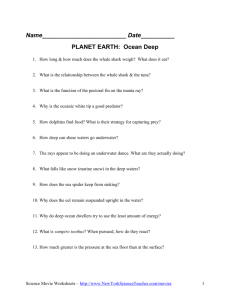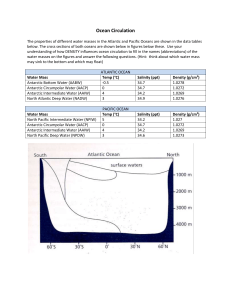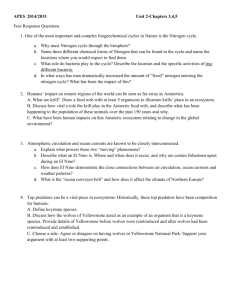Interdependence - What is going on in the Antartic Ocean
advertisement
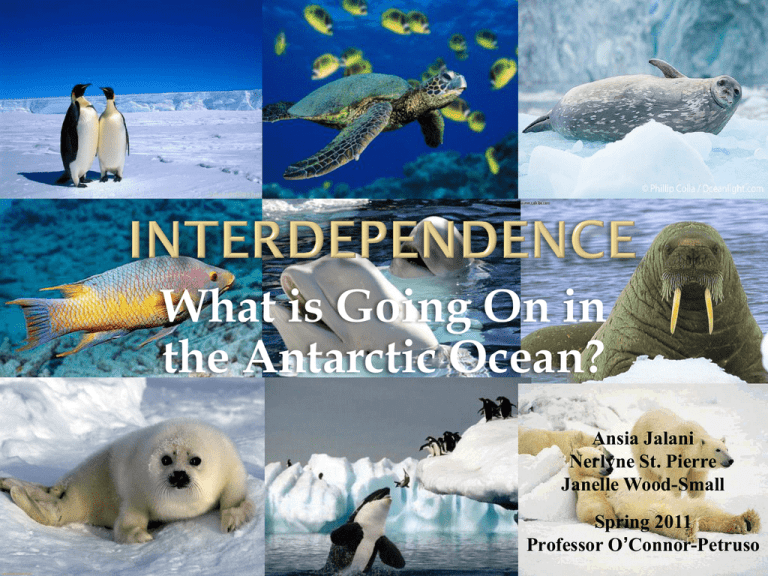
What is Going On in the Antarctic Ocean? Ansia Jalani Nerlyne St. Pierre Janelle Wood-Small Spring 2011 Professor O’Connor-Petruso Overview Standards MST Lessons o Lesson 2: Predators and Prey! - Scavenger Hunt o Lesson 3: Producers, Consumers, Decomposers Oh My! - Graphic Organizer - Spreadsheet and Congruent Graph - PET Manipulative Skill o Lesson 6: What’s Your Impact? - Web 2.0/Filamentality Multimedia Elements & Online Resources Gardner’s Intelligences Additives Naturalist •Grouping Objects Lessons Lesson 1 Title Who or What lives there? Blooms Taxonomy Knowledge Comprehension Lesson 2 Predators and Prey! Comprehension Evaluation Lesson 3 Producers, Consumers, Decomposers Oh My! Analysis Synthesis Lesson 4 Those who Adapt Survive! Comprehension Analysis Interpersonal Visual Naturalist •Flash Cards •Grouping Objects •Spreadsheet •Bar/Pictograph •Graphic Organizer •Food Web Power Point Game •Spreadsheet •Time Line •Graph Lesson 5 Survival techniques Synthesis Interpersonal Visual Naturalist •Smart board •Cause & effect flow map Lesson 6 What’s Your Impact? Evaluation Verbal/linguistic Naturalist Kinesthetic Logical Verbal/linguistic Naturalist Visual/spatial, Bodily/kinesthetic, logical/mathematical •Computer •Scavenger hunt •Website•Blog •Flashcard •Brain Pop NCTM Math Skills: Process Standards Problem Solving Apply and adapt a variety of appropriate strategies to solve problems Content Standards Represent data using tables and graphs such as line plots, bar graphs, and line graph. Collect data using observations, surveys, and experiments. NAEP Process Skills S4.2: Conduct scientific investigations using appropriate tools and techniques (e.g., selecting an instrument that measures the desired quantity length, volume, mass, weight, time interval, temperature with the appropriate level of precision); S4.3: Identify patterns in data and/or relate patterns in data to theoretical models; Technology T4.3: Apply science principles or data to anticipate effects of technological design NAEP Science Content Standard: L4.1: Organisms need food, water, and air; a way to dispose of waste; and an environment in which they can live. L4.2: Organisms have basic needs. Animals require air, water, and a source of energy and building material for growth and repair. Plants also require light. L4.3- Organisms interact and are interdependent in various ways including providing food and shelter to one another. Organisms can survive only in environments in which their needs are met. Some interactions are beneficial; others detrimental to the organism and other organism. Behavioral Objectives: Students will be able to identify the organisms who are predators and prey in the Antarctic Ocean based on the scavenger hunt. Students will be able to work as a team in the scavenger hunt. Students will be able to create a chart and bar graph based on the predators and prey. Motivation: Teacher will discuss yesterday’s lesson with the class. Teacher will inform the class that we will go on a scavenger hunt on laptops. Procedure: Two Days Teach: Teacher will introduce new vocabulary and review important information from the previous lesson. Class Activity: The class will visit the filamentality /web 2.0 page and the websites that will be necessary to conduct the scavenger hunt. Group Activity: In groups will work on a laptop and visit the filamentality /web 2.0 page to scavenger hunt for answers to questions on a worksheet. Objective 1: Students will be able to identify the organisms who are predators and prey in the Antarctic Ocean based on the scavenger hunt. Objective 2:Students will be able to work as a team in the scavenger hunt. Name_________________________________ Date__________________________ Scavenger Hunt Directions: Please explore the websites and answer the following questions in complete sentences. 1 - Define prey in your own words. A prey is an animal that is hunted for food. 2 - Define predator in your own words. A predator is an animal that hunts other animals for food. 3 - What is another name for a meat-eating animal that is sometimes given to polar bears? They are also called carnivores. 4 - Where does a polar bear catch it prey and what animal is it that a polar bear eats mainly? Polar bears catch their prey in the water and they eat mostly seals. 5 - Name three animals that are predators to squids. Three animals that prey on squids are sharks, whales and fish. 6 - What is one defense mechanism that Petrol birds do to fend off predators? They bring up the oils in their stomach to fight off predators. 7 - What animal is a predator for penguins? Leopard seals are predators for penguins. 8 - A crabeater seal does not eat crabs like its name says, but what small animal does it eat? A crabeater seal eats krill. 9 - Orcas (Killer whales) prey on what animal? Orcas prey on cod. 10 - Seals, whales, penguins, fish and other birds all eat this small animal that resembles a shrimp, what animal is it? All these animals eat krill. Objective 3: Students will be able to create a chart and bar graph based on the predators and prey Name________________________________ Directions: Answer the following questions and create a chart and bar graph on the organisms that are prey for other organisms. 1. List the organisms that are prey according to your scavenger hunt sheet. Organisms that are prey are: krill, squid, seals, penguins and cod. 2. List the number of predators that each of the organisms have according to your scavenger hunt sheet. Krill has 4 predators. The seal, whale, penguins and fish. Cod has 1 predator, the whale. Penguins have 1 predator, the leopard seal. A squid has 3 predators, the sharks, whales and fish. Seals have 1 predator, the polar bear. Bar Graph Organisms Krill Cod Penguins Squid Seals Chart Number of Predators 4 1 1 3 1 Behavioral Objectives: Students will be able to classify organisms as producers, consumers or decomposers and use a spreadsheet to display this information Students will be able to use the information from the spreadsheet to create a bar and a pictograph. Students will be able to create a food web using a graphic organizer. Motivation: The teacher will lead a shared reading of Eyewitness: Ecology by Steve Pollack. This book is excellent to introduce the topic of ecosystems and organisms roles in their ecosystem. Procedure: Teach: Teacher will define vocabulary words, characteristics of producers, consumers and decomposers; and visit websites to learn how to create food chains and food webs. Class Activity: The class will play food web game; and explore organisms in the workstations. Group Activity: Groups will work in their workstations to classify organisms; create spreadsheet and graphs; and create a food web using a graphic organizer. Objective 1: Students will be able to classify organisms as producers, consumers or decomposers and use a spreadsheet to display this information. Consumer Secondary Primary Producer Decomposer Objective 2: Students will be able to use the information from the spreadsheet to create a bar and a pictograph. Organism Organis m Organism Organism Organism Killer Whales Whales Seals Fishes Penguins Krill Shrimp Small Fishes Squid Phytoplankt on Seaweed Zooplankto n Aquatic Plants Bacteria Marine Worms Organisms Found in Workstation 10 Sea Birds 8 Quantity 6 4 2 0 Consumer Objective 3: Students will be able to create a food web using a graphic organizer. Killer Whale Producer Decomposer Classification Whale Krill Seal Shrimp Unicellular life Forms Fish Small Fishes Unicellular life Forms Penguin Squid Unicellular life Forms Behavioral Objectives: Students will be able to interpret how the loss of habitat, food source, and any predator or prey can effect an animal. Students will be able to evaluate the connection between human action and effects on Antarctic Ocean animals. Students will be able to recommend 2 or more ways other students can help the animals of the Antarctic Ocean. . Motivation: The teacher will remind students of what they learned last week, animals, habitat, predators, prey, producers, consumers, decomposers, and adaptations. Today students will utilize what they learned to analyze and evaluate the role s kids can play in hurting or helping the animals of the Antarctic Ocean. Teacher will show Brain POP’s video Endangered and extinct animals. Teacher will facilitate a yarn web food chain, with a twist, krill will drop their string due to pollution and global warming, other animals will disappear due to hunting. Procedure: Teach: Teacher will introduce new vocabulary of endangered and extinct Teacher will model how to use the class web page to gain more information about their animal. Teacher will model how to use storyboard questions and graphic organizer to prepare blog entry. Teacher will show what a blog looks like, how to create one and what a level 3 blog should include.. Class Activity: Working as a class they will discuss human impact on the Antarctic Ocean animals, they will discuss in their groups ways they can help. Research facts about their animal. Complete story board questions, map and Create a blog. Group Activity: Food Web Yarn game- with certain species dying. Class blog for Class website. http://antarticoceankids.weebly.com/antarctic-ocean-animals-blog.html Story Board Questions and Graphic Organizer Directions: Please answer the following questions to help you complete the story board about your animal. Once you have completed the story board draft, you can write your blog entry on our website. Be sure to use the Antarctic Ocean Kids website for assistance. http://antarticoceankids.weebly.com/final-project.html 1 – What is the name of your animal? Blue Whale 2 – Where does your animal live? What habitat? In most oceans, including the Antarctic Ocean. But prefers warm water. 3 – What does your animal eat? They eat small fish, especially krill. 4 – What are the predators of your animal? Humans. 5 – What are interesting facts about your animal? Their heart is the size of a car. They stay with their young for 6 months. They can get as big as 130 feet long. 6 – How are we interdependent with your animal? Why is it important to protect them? They eat krill. Krill is decreasing, their population is decreasing. Creates an imbalance in our ecosystem. 7-Knowing what you know now about food webs, what happens if your animal disappears completely? The Orca Whale Population will decrease because they are the natural predator of the Blue Whale. Rationale: It is extremely important that every American child is technological savvy. It is as equally important that children learn how to navigate the internet with a responsible adult, such as a parent or a teacher. We find it necessary to create a filamentality web page for our MST unit plan because it will give us the opportunity to introduce our students to conducting responsible research on the internet. This filamentaity web page contains games, songs/audio, and links to other websites that will give our students more information on the topic of interdependence. We have also created a website that will allow our students to blog and post their ideas. Our students Will simultaneously learn how to navigate the world wide web while they use these Multimedia resources to learn about interdependence in the Antarctic Ocean. Filamentality Web Page http://www.kn.att.com/wired/fil/pages/listtheantaaj.html Antarctic Ocean Kids’ Website http://antarticoceankids.weebly.com/index.html Interdependence Songs/Audio http://www.songsforteaching.com/environmentnature/interdepende nceday.htm Class 4-101 Presents… Interdependence in the Antarctic Ocean Teachers Ms. Jalani Ms. St. Pierre Ms. Wood-Small Who Wants to Be a Millionaire: A team will consist of one member from each group A team member may use three life lines: 1. Poll the group. The members of your group will hold up the letter of their choice. 2. 50/50 elimination of the choices. Mrs. Small will narrow the choices to 2. 3. Ask an expert- You may ask anyone in the class that you chose in the beginning of the game. Who Wants To Be a Millionaire? Special Edition: Interdependence Host: 4-101 $100 The Antarctic Ocean is… A. Located right next to New York City B . Boiling hot C A mix of the Indian Ocean and the Atlantic Ocean D Near Ocean Avenue The Antarctic Ocean is… A Located right Next to NYC B Boiling Hot C A mix of the Indian Ocean and the Atlantic Ocean D Near Ocean Avenue Question 2 $200 All of these are consumers in the Antarctic Ocean except… A. Elephant seal B. Phytoplankton C. Baleen Whale D. Krill All of these are consumers in the Antarctic Ocean except… A. Elephant seal B. Phytoplankton C. Baleen Whale D. Krill Question 3 $300 These are all animals that migrate but one of them is not found in the Antarctic Ocean. Which one? A Baleen Whale B Cod fish C Greenland shark D Small tooth whale These are all animals that migrate but one of them is not found in the Antarctic Ocean. Which one? A Baleen Whale B Cod Fish C Greenland Shark D Small tooth whale Question 4 $400 Which human behavior can hurt animals in the Antarctic Ocean? A polluting B breathing C growing D planting Which human behavior can hurt animals in the Antarctic Ocean? A. polluting B. breathing C. growing D. planting Question 5 $500 During the winter, the Antarctic Cod falls into a deep sleep. This is called A. hibernation B. migration C. camouflage D snoring During the winter, the Antarctic Cod falls into a deep sleep. This is called A hibernation B migration C camouflage D snoring Question 6 $600 An animal that eats plants or other animals is a A. predator B . consumer C. bacteria D . greedy An animal that eats plants or other animals is a A. Predator B . Consumer C . bacteria D greedy Question 7 $700 These adaptations help the Weddel Seal’s survive in the Antarctic Ocean except… A. Fat under their skin B. A thin layer of dense fur C . They can hold their breath for one hour D. They hibernate These adaptations help the Weddel Seal’s survive in the Antarctic Ocean except… A fat under their skin B a thin layer of dense fur C They can hold their breath for an hour D They hibernate Thank You! http://www.amnh.org/ology/index.php?channel=biodiversity# http://video.kidzui.com/channels/Ecosystems http://www.kidskonnect.com/subject-index/15-science/77-food-chain.html http://www.kidsgeo.com/geography-for-kids/0164-ecosystems.php http://www.kids-courier.com/kids_learning/science/scienceeco_aqua.html http://www.antarcticconnection.com/antarctic/wildlife/index.shtml http://www.coolantarctica.com/Antarctica%20fact%20file/wildlife/whales/food %20web.htm http://www.vtaide.com/png/oceanchain.htm http://www.woodlandsjunior.kent.sch.uk/Homework/adaptations/penguins.htm http://www.polarcruises.com/antarctica/articles/wildlife_4/sealadaptations_11.htm http://www.mbgnet.net/sets/index.htm http://pbskids.org/mypbskids/ http://antarticoceankids.weebly.com/index.html “http://video.nationalgeographic.com/video/player/places/parks-andnature-places/oceans/oceans-antarctica.html Blue Whales (n.d.). Retrieved from http://a-z-animals.com/animals/blue-whale/ http://www.blue-whale.info/Predators_of_the_Blue_Whale.html Extinct and Endangered Species. FWD Media. BrainPOP. Web 8 May 2011. http://www.brainpopjr.com/science/conservation/extinctandendangeredsp ecies/ The International Seekeepers Society. "Plankton & Krill Levels Rapidly Decreasing." International See Keeper Society, N.D. Web. 4, April 2011 http://www.seakeepers.org/featured-plankton.php Ansia Jalani Nerlyne St. Pierre Janelle Wood-Small Spring 2011 Professor O’Connor-Petruso
